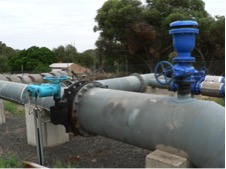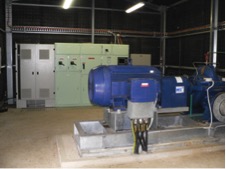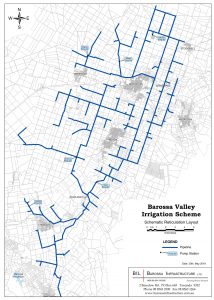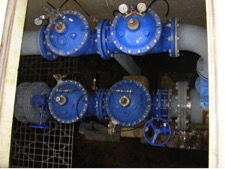Our Vision
“To provide a high quality water supply in the Barossa which, when applied in environmentally and viticulturally appropriate quantities, sustains crop yield and quality through dry periods at a cost that is lower than other quality water sources.”
BIL’S PURPOSE
BIL’s mandate is to provide a high-quality irrigation water supply at the lowest sustainable price.
BIL originated out of a desire to:
- Replace use of increasingly saline local groundwater with high-quality water suitable for viticulture on a range of soils,
- Supplement natural rainfall to drought proof vineyards in years of low rainfall, and
- Relieve pressure on the domestic water supply which was unable to cope with high demand during regular summer hot spells.
Since first water in 2001, BIL has provided approximately 135,000 ML of supplementary irrigation water to customers within the floor of the Barossa Valley.
The water is not suitable for human consumption.
OWNERSHIP AND GOVERNANCE
As an unlisted public company started in 1998, BIL’s shareholders are also its customers (and nearly all customers are shareholders). BIL shares are held in proportion to each customer’s contracted volume of Premium water (Premium water can be taken year-round, whereas Off Peak water is for shoulder and winter periods).
BIL is governed by a Board of Directors, comprising of shareholders and non-shareholders. Board members are vignerons, wine makers, accountants, business advisors, and scientists.
FUNDING
BIL shareholders have fully funded the scheme. The original scheme in 2000 cost approximately $30 million, funded 1/3 by share purchase and 2/3 by a long-term bank loan. This was paid off in 2016. Subsequent expansions have followed this same arrangement.
Customers pay an annual infrastructure levy to assist in paying off any loans and to provide funds for the purchase of River Murray water entitlements. The infrastructure levy applies to new customer water contracts on a volume basis and varies based on the cost of each expansion. The infrastructure levy is typically paid off over an 8 to 15-year period and once paid off no further infrastructure levies are payable on that water.
Premium water customers are also required to be shareholders. The funds from share purchases also go towards paying off loans and for River Murray water entitlements.
Customer water use charges are ongoing and are used to fund the direct cash operating costs and administration overheads.
BIL’s shareholders/customers have contributed in the order of $100 million through share purchase and infrastructure levies (excluding water use charges) to secure their water needs.
TYPICAL CUSTOMER CONNECTION

BIL OFFTAKE AT FROMM SQUARE

INSIDE AIRFIELD PUMPING STATION

No Government funding was received for the construction or subsequent expansions of the scheme. BIL is grateful for the considerable assistance provided by the SA Government and SA Water in negotiating permits and access to infrastructure. BIL has received two grants to upgrade customer water meters:
- the Private Irrigation Infrastructure Program for South Australia (PIIP) allowed BIL to replace mechanical customer meters with highly accurate magflow meters; and
- the SA River Murray Sustainability Irrigation Industry Improvement Program (3IP) enabled BIL to complete customer meter automation, allowing growers to remotely access their flow rate and consumption information.
WATER SOURCES
BIL’s primary water source is SA Water’s Warren Reservoir, which is supplemented with River Murray water via SA Water’s Mannum-Adelaide pipeline. In this way water is delivered to BIL’s infrastructure near Williamstown. At SA Water’s discretion, SA Water can also choose to supply BIL chloraminated water via the Swan Reach-Stockwell pipeline, connecting to BIL at the same Williamstown location. BIL obtains River Murray water allocations for all water delivered in this way.
BIL has a highly effective long-term working relationship with SA Water, underpinned by a Water Transport Agreement. BIL has made multiple capital contributions to fund expansion of SA Water’s assets to meet BIL’s requirements.
BIL also receives treated municipal wastewater from Barossa Council, which is blended with River Murray water and supplied to a limited number of customers. This represents approximately 2.5% of BIL’s water supply.
BIL’S INFRASTRUCTURE
BIL delivers up to 11,000ML per annum of water across an area of 450km2 in the Barossa Valley floor. BIL has a network of:
- Approximately 500 water delivery points for our roughly 300 customers. Each water delivery point contains a flow control device and a flow meter with telemetry unit that allows customer to view their historical flow rates and consumption via the internet.
- 200km of pipeline ranging in diameter from 150mm to 960mm. These extend from Williamstown in the south to Ebenezer in the north, and Lyndoch / Gomersal / Greenock in the west to Rowland Flat / Bethany / Light Pass / Stockwell in the east.
- Six pump stations ranging from 30L/s to 600L/s that help keep pipeline pressures at a level where many customers can irrigated directly from BIL
- 32 pressure reducing valves to protect pipelines and customer connections from high pressures in some parts of the network, and
- One 500ML water storage in the Ebenezer area to meet demand during summer peak conditions.
BIL operations staff can remotely control the pump stations and a number of valves, and can remotely monitor pump performance and pipeline pressures, via a SCADA system.
ENVIRONMENTAL CONSIDERATIONS
BIL and its customers are dependent on a strong environmental commitment to ensure sustainability of BIL and the Barossa.
BIL’s water is supplementary to the average Barossa rainfall of 500 mm per annum. Water application rates vary between growers, sub-regions, grape varieties, and the prevailing weather, but typically amount to 1-2ML/ha per annum.
The supply of high-quality supplementary irrigation is required to:
- ensure adequate water for the health of the vines and production of premium wines,
- replace inferior quality (saline) water, either groundwater or surface water,
- supply additional water due to annual variation in rainfall,
- ensure Barossa catchment water harvesting is at sustainable levels,
- correct the negative correlation between yield and quality with increasingly saline irrigation water, and
- avoid mining of deep aquifer water for irrigation, leading to the importation of salt to surface soils.
ENVIRONMENTAL ASSESSMENT
BIL has commissioned 3 environmental reports on the impact of importing Warren Reservoir / River Murray water into the Barossa Valley, as well as a number of reviews of the impact of supplementary irrigation on the local water tables. Copies of the environmental reports and the most recent assessment of CWMS water are available on BIL’s website on the Environmental Assessments and Water Quality pages.
The environmental issues that have been addressed included:
- the potential for the use of BIL water to result in a rise in regional water tables,
- the effects on the salt budget and the potential for increases in the salt load entering surface drainage as base flow,
- the potential for the creation of perched water tables with adverse effects on plant growth and for migration off-site, and
- the effects of any changes in salinity and chlorine residuals on ecosystems and the implications of inter-basin transfer of water.
Resolution of all environmental issues was required before approvals were granted and the Scheme constructed.
Similarly, an independent assessment of the safety and environmental effects of the use of treated wastewater from the Barossa Council’s CWMS was undertaken by BIL prior to supply of this water. Ongoing annual reports on its impact are undertaken and also available on BIL’s website.
GROUNDWATER
BIL commissions a review on the shallow ground water table every two to three years to ensure there are no detrimental impacts due to the use of imported River Murray water.
To date there has been no detrimental impact on the environment, and in fact the improvement in groundwater over the past 20 years has been attributed to irrigators switching to the BIL scheme. Salinity of the water supplied to BIL customers is typically between 150mg/L and 300mg/L TDS, whereas local groundwater is highly variable across the valley and between the three aquifers and ranges between 500mg/L to greater than 6000mg/L.



